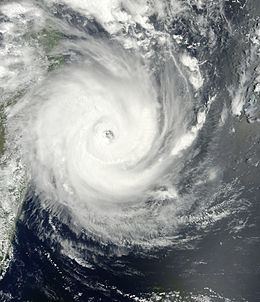Formed February 7, 2012 Fatalities At least 35 | Dissipated February 24, 2012 | |
 | ||
Highest winds 10-minute sustained: 195 km/h (120 mph)1-minute sustained: 230 km/h (145 mph) Lowest pressure 935 hPa (mbar); 27.61 inHg Date 7 February 2012 – 24 February 2012 Similar Tropical Storm Irina, Cyclone Bingiza, Cyclone Funso, Cyclone Geralda, Cyclone Ivan | ||
Intense tropical cyclone giovanna
Intense Tropical Cyclone Giovanna was a powerful tropical cyclone that affected Madagascar. Giovanna was the ninth tropical depression, seventh named storm and third tropical cyclone of the 2011–12 South-West Indian Ocean cyclone season. Giovanna is still blamed for 33 deaths along the Madagascar coast, and it is the first intense tropical cyclone to impact Madagascar, since Cyclone Bingiza in February 2011.
Contents
- Intense tropical cyclone giovanna
- Tropical cyclone giovanna 2012 02 13 720p
- Meteorological history
- Preparation and impact
- References
Tropical cyclone giovanna 2012 02 13 720p
Meteorological history
Cyclone Giovanna developed from a tropical wave over the Indian Ocean heading to the southwest on February 7. The tropical disturbance soon developed into Tropical Depression 09 on February 9. That same day the JTWC upgraded the system into 12S. The storm intensified into a moderate tropical storm and was given the name Giovanna. On February 10, Giovanna continued to strengthen into a severe tropical storm. Later the same day, Giovanna went through a rapid intensification and became an intense tropical cyclone, due to favorable conditions and great convection wrapping around the system.
Soon, Giovanna began an eyewall replacement cycle and weakened into a tropical cyclone on February 11 due to high wind shear surrounding the system. However, the wind shear surrounding Giovanna soon weakened and Giovanna was able to strengthen back into an intense tropical cyclone, and finished the eyewall replacement cycle resulting with a new, larger eye at 50 kilometers across.
At about 2200 UTC February 13, Giovanna made landfall on Andovoranto, Madagascar. Giovanna then weakened into an overland tropical depression on February 14. Early on February 15 Giovanna moved back out into open water.The storm soon drifted southwards, on February 18, as Giovanna moved eastwards, along the bottom of Madagascar, the storm was steered into warmer waters, by a strong Anticyclone located south of Giovanna where it strengthened into a Category 2 tropical cyclone again, and developed a small eye.However the eye soon underwent an eyewall replacement cycle, and developed double eye walls due to moderate wind shear. On February 20, Giovanna entered an area of strong vertical wind shear which quickly weakened the system into a tropical depression and displaced the system's convection to south of the system's exposed circulation center. This caused Giovanna to dissipate into a remnant low, with the low level circulation center totally exposed by the next day. The exposed remnants were soon pushed further northwest the next day, due to the Fujiwhara interaction between the much stronger system in the east, Moderate Tropical Storm Hilwa, before Giovanna's remnants finally dissipated east of Madagascar, late on February 21.
Preparation and impact
Large waves estimated up to 8 m (26 ft) affected the coast of Reunion and resulted in one fatality after a man was swept out to sea. Another fatality took place in Mauritius after a man lost control of his motorcycle during poor weather and crashed into an electricity pylon.
At least 33 people were killed by Giovanna in Madagascar. Flooding and strong winds were the main destructive forces, besides the storm surge which floods many coastal areas. Thousands of people were affected by this cyclone all across Madagascar with, flooding and strong winds which mostly caused 60% of homes to be damaged or destroyed. Two villages on small islands near Madagascar were reportedly "wiped off the map." Reports indicated that 75 to 90% of structures in those areas were destroyed by the storm.
The high winds from the cyclone uprooted trees and electricity pylon, which caused power cuts and emergency service vehicles have been out in Antananarivo on Tuesday clearing up the debris. People are staying at home as offices, schools and businesses have been shut and the power has been cut in many areas. Meteorologists warn the damage may be as bad as in 1994, when Cyclone Geralda killed 200 people and displaced 40,000.
